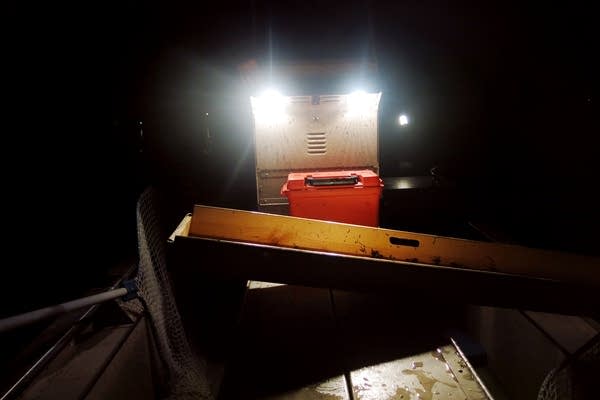On Pelican Lake, a search for muskies, data and understanding

Go Deeper.
Create an account or log in to save stories.
Like this?
Thanks for liking this story! We have added it to a list of your favorite stories.
The "Danger — High Voltage" sign makes it clear: This isn't your typical fishing boat.
"We're doing something that you're told never to do, and that is use electricity in water," said Jim Wolters as he unloaded the boat while a brilliant orange sunset reflected across a calm Pelican Lake. "But we do it safe."
Wolters, an area fisheries manager for the Minnesota Department of Natural Resources, and his three-person crew was about to go electrofishing — research that requires darkness, calm water, spotlights and a generator.
It's part of an effort to collect data on the muskellunge, the big, enigmatic fish whose success in Pelican Lake generates praise and scorn.
Turn Up Your Support
MPR News helps you turn down the noise and build shared understanding. Turn up your support for this public resource and keep trusted journalism accessible to all.
For years, the DNR has stocked the lake with muskies. Lake homeowners, though, say it's gone too far and that the muskie grow into monsters, eating all the food and damaging the walleye fishery.
The DNR says data doesn't support that argument, but lawmakers aren't so sure. There's an effort at the Legislature now to stop the DNR from stocking new lakes with muskies, so conservation officials are trying to answer the concerns by gathering more data.

Collecting that information requires patience — and power.
About a dozen wires dangled from two pipes that extend ahead of Wolters' boat. When the crew spotted a muskie in shallow water, they kicked a switch, dropping a 300-volt charge into the water.
"We're basically shocking those fish so they're not able to swim away from us when we're trying to net 'em," Wolters said. Knocks 'em out for a minute or two."
A cousin of the northern pike, the muskellunge has a passionate following among anglers. They grow slowly, but 48-inch catches are not uncommon. Anglers can't keep a fish unless it's at least 54 inches. The DNR manages muskie as a trophy fish and Pelican has a reputation as a trophy lake. The DNR stocks about 800 small muskies here each year.

Muskies were introduced here in 1978, but "this is the first time that we've actually done these population estimates for muskies here in our Otter Tail muskie lakes," Wolters explained as the boat pulled into a small lake connected to Pelican where muskie like to come to lay eggs in shallow water, making it a good place to catch the otherwise elusive fish.
"Generally speaking, around here, what we would like to see is one fish for every four acres," he said, "a maximum population of anywhere from 700 to 900 muskies."
Wolters and fisheries technician Ron Erickson plugged in the electrodes. Fisheries specialist Steve Kubeny fired up the generator and drove the boat while Wolters and Erickson stood on a deck up front and swept spotlights across the calm water penetrating to the lake bottom. Fish glided through the light, offering a split second to determine if it was a muskie. It took some concentration.
"Until you see that first one in the light, it's kind of hard to envision what they look like," said Wolters. "There'll be a fish you swear is only 20 inches but when you net it, it might be a 36- or 38-incher."
A muskie surfaced. Erickson kept his spotlight on the fish while Wolters grabbed a long handled net and shouted instructions. The fish ran 43 inches, about the average size for Pelican Lake. The team saw one just over 50 inches earlier this spring.
After a fish is shocked, it's netted, hauled aboard, measured and a small electronic tag is injected under the skin so the individual muskie can be tracked over time.

This year 35 muskies were captured and tagged on Pelican and adjoining lakes in five nights of electrofishing. The DNR is also tagging all the young muskie stocked here for seven years and is using electronic tags on muskie in several lakes across the state.
Wolters will use a formula to develop a muskie population estimate for Pelican lake later this month. He plans to share that information with local residents concerned about too many muskies. "There's a lot of valuable information we're going to be getting here in the next 10 to 15 to 20 years."
That will help better understand survival rates and population growth, he said, adding that he's hopeful science will win over the skeptics.


